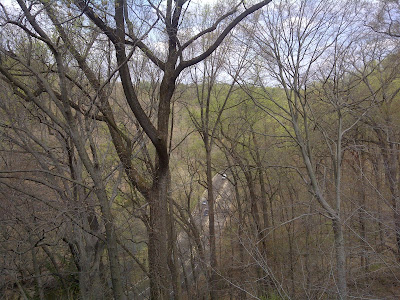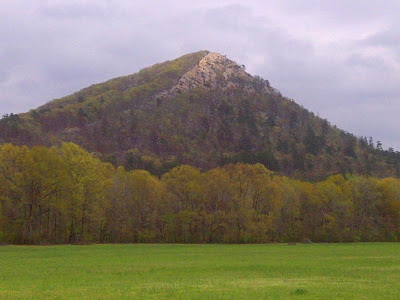When most people think of Philadelphia, it is unlikely that hiking comes to mind. But I'm hoping this post will change that! Philadelphia is home to Fairmount Park, the largest urban park system in the United States. And the gem of the Fairmount, in this blogger's opinion, is the Wissahickon Gorge Orange Trail.
 |
| Follow the orange blazes of the Wissahickon Gorge Orange Trail |
The Wissahickon Gorge Orange Trail is a rugged, single-track, dirt-stone-and-root-strewn path that follows the namesake creek's northern and eastern banks and along the lower gorge wall. Higher up the gorge wall, the White Trail follows a near parallel path. Forbidden Drive is the heavily traversed, wide and smooth, multi-use trail that follows the creek on its opposite shore.
It's an enigma wrapped in a riddle, as they say. The wooded path that is the Wissahickon Gorge Orange Trail appears on maps to be too close to the city to be enjoyed as an apparent wilderness. Its location deep within the Wissahickon Gorge, however, makes it so. For at least two-thirds of the trail's length, the gorge is practically free of urban noise pollution (with the exception of the occasional scream of emergency vehicle). Otherwise, the sounds of the creek, birds chattering, and wind blowing through the canopy of trees are all you will hear along the Orange Trail.
 |
| Enjoy the lush riparian environment of the Wissahickon Gorge Orange Trail |
The Wissahickon Gorge Orange Trail makes its way from the northwest reaches of the city, at Chestnut Hill College along East Northwestern Avenue, to the Schuylkill River, near the intersection of Lincoln and Kelly drives at the Wissahickon Transportation Center. This thru-trail is approximately 7.5 miles from start to finish, and it can be done in about 3.5 to four hours, depending on your personal speed.
You won't find outfitters in Philadelphia to shuttle you from one end of the trail to the other. So the best way to enjoy this trail is to reach the trailhead via public transportation, provided frequently, conveniently and economically by the Southeastern Pennsylvania Transportation Authority (SEPTA).
From the Olney Transportation Center (Broad Street Line Subway), board the L bus going west toward Plymouth Meeting and get off at the gates of Chestnut Hill College, at the corner of Germantown Pike and Rodgers Drive. The trail begins by crossing the south side of the bridge. From there, the trail veers to the right and hugs Wissahickon Creek, which will remain on your right hand side for the entirety of your hike.
At about the half-mile point you will cross West Bells Mill Road, and just past the one-mile point you will arrive at a covered bridge. Built in 1737, this is the only remaining covered bridge of the many that once crisscrossed the creek in the area.
 |
| Covered bridge along the Wissahickon Gorge Orange Trail |
Enjoy the many views of the bridge, then find your way back to the trail, which continues on the other side of the picnic area there. Within a half mile of passing the covered bridge, keep your eyes directed up the slopes of Wissahickon Gorge and you will see a statue of a kneeling Lenape warrior atop a large rock outcrop called Council Rock.
It is worth it to take the short connector trail up to the top of Council Rock to see the statue up close. According to the Friends of the Wissahickon's 2013 Map of the Wissahickon Valley Park, this 1902 statue stands "where the Lenape are believed to have held gatherings."
Return to the Orange Trail, and the next mile or so past Council Rock is some of the most beautiful terrain you will encounter along the Orange Trail. There is a section with dozens of rhododendron bushes which, if you're lucky, you'll get to see in bloom. This, according to the National Rhododendron Society, occurs in the Philadelphia area from mid-May through the first week of June.
 |
| Civilization along the trail at Valley Green Inn - trail maps available here |
At approximately 2.5 miles into your hike you will come across a bridge that gives you access to the Valley Green Inn, which has public restrooms for hikers as well as a restaurant with a full menu, making it a wonderful lunching spot along your hike. Even if you packed your lunch, I recommend you stop here for a cup of coffee to enjoy the view from the veranda. On a recent hike, I had a serendipitous encounter with a bald eagle and the Irish folk band Scynthian. (Read more about that
here.)
 |
| Devil's Pool, along the Wissahickon Gorge Orange Trail |
Continuing on, you will come across Devil's Pool at the three-mile mark. This is a spot of deep water along the Wissahickon, where it is joined by Cresheim Creek. Just beyond Devil's Pool, which is a popular spot for swimmers even though the official park policy bans swimming, you will reach the historic Livezey House (also known as Glen Fern).
From this point on the trail begins to feel a bit more civilized, especially at the 3.5-mile mark, where you encounter the Fingerspan Bridge, designed by artist Jody Pinto, which was airlifted into place by a helicopter in 1987.
 |
| Fingerspan Bridge, designed by artist Jody Pinto, along the Orange Trail |
Another mile or so down the Orange Trail you will reach a sharp bend in the Wissahickon Creek. Just beyond the curve you will reach a rock outcropping called Mom Rinker's Rock, named after a reputed witch who, according to local lore, would drop balls of yarn containing messages about British troops to Colonial soldiers waiting below. A spur trail takes you to the top of Mom Rinker's Rock where you will find the Toleration Statue (placed here in 1883).
 |
| Tolerance Statue, atop Mama Rinker's Rock, Wissahickon Gorge |
Just before the five-mile point you will cross under the Walnut Lane Bridge, which looms high above the creek. Enjoy the graffiti here and continue on. In another half mile or so you will reach historic Rittenhouse Town, which is home to several historic homes, the last remains of a bustling mill town established in 1690.
At Rittenhousetown, you will follow the sidewalk uphill along Lincoln Drive to the intersection of Lincoln and Rittenhouse Street at the southern end of Saylor's Grove. Cross the drive here - carefully - and on the other side of Rittenhouse Street you will find the Wissahickon Gorge Orange Trail picks up to the right.
 |
| Graffiti at the Henry Avenue bridge, Orange Trail, Philadelphia University |
This last portion of the trail, which continues south along the gorge high above Lincoln Drive all the way to its intersection at Ridge Avenue, is the least-traveled of the Orange Trail. In fact, the new map put out by the Friends of the Wissahickon no longer designates it with the Orange color - but to miss out on this portion of trail would be a mistake. One feels like a voyeur over the traffic below, and a sense of accomplishment mounts as you gently make your way back into civilization.
 |
| Lincoln Drive as seen from the Orange Trail, near Philadelphia University |
Here are all the important stats you'll need to enjoy your day hiking the Wissahickon Gorge Orange Trail:
Trailhead: The start of the trail is near the gates of Chestnut Hill College. Take the L bus from SEPTA's Chestnut Hill West Station or the Broad Street Line's Olney Transportation Center and tell the driver you want to get off at the college on the corner of Germantown Pike and Rodgers Drive
(not all of the buses stop there, so check the SEPTA schedule
here). Conversely you may start the trail from northeast corner of Lincoln and Kelly drives, which is accessible by a slew of buses and Regional Rail at Wissahickon Station.
Distance: 7.5 miles one-way (15 miles out-and-back)
Elevation Gain/Loss: Estimated 100-300 feet (30-90 m). The elevation change is 100 feet (30 meters), but the trail has a lot of ups and downs, so until I can get a GPS reading I've included an estimate here.
Map: Friends of the Wissahickon and Philadelphia Parks and Recreation have just put out a 2013 Map of the Wissahickon Valley Park, which you can pick up at several locations in and around the City of Philadelphia, including at the Valley Green Inn, along Forbidden Drive in the park. You will find more information about the map and where to get it
here. Also, find information on the Wissahickon Gorge's geography and geology in this
1997 report.
Hiking Time: 3.5 to four hours, depending on your personal speed.
Best Times to Hike: This hike can be done year round, but snow and ice may impede enjoyment without snowshoes or crampons in the winter. Springtime is mud season, but you can avoid the mud by rock hopping.
Difficulty: Easy
 |
| Buses galore return to Center City from the Wissahickon Station |
For another scenic hike higher up in the Wissahickon Gorge, check out the
White Trail. And for more information on this hike or other hikes discussed in the blog HikeyHikey, feel free to leave a comment below. Check out my other blogs
Man of Merit and
MyFitLife2Day. Or contact me via my splash page at
about.me/brian.schwarz.





















